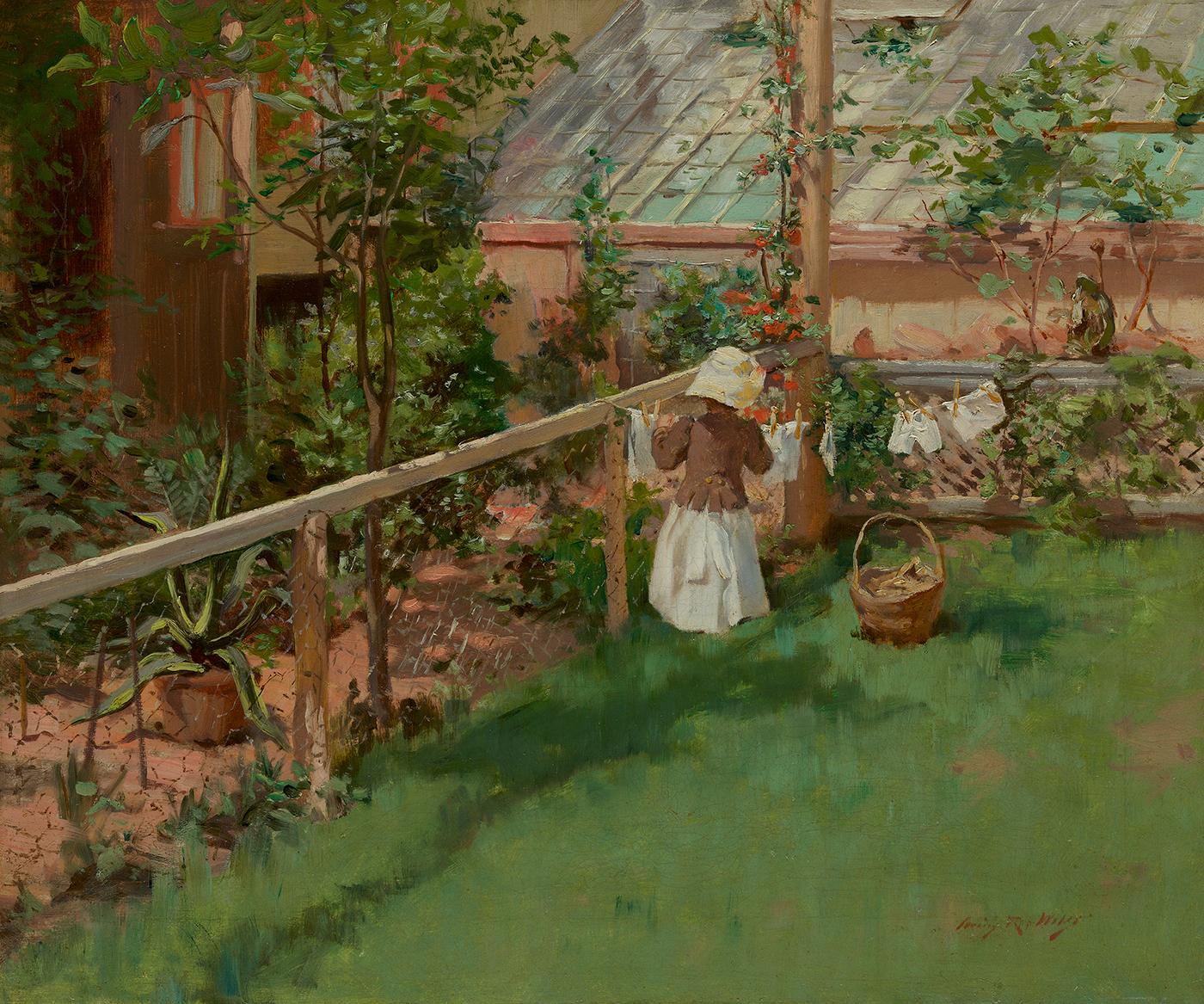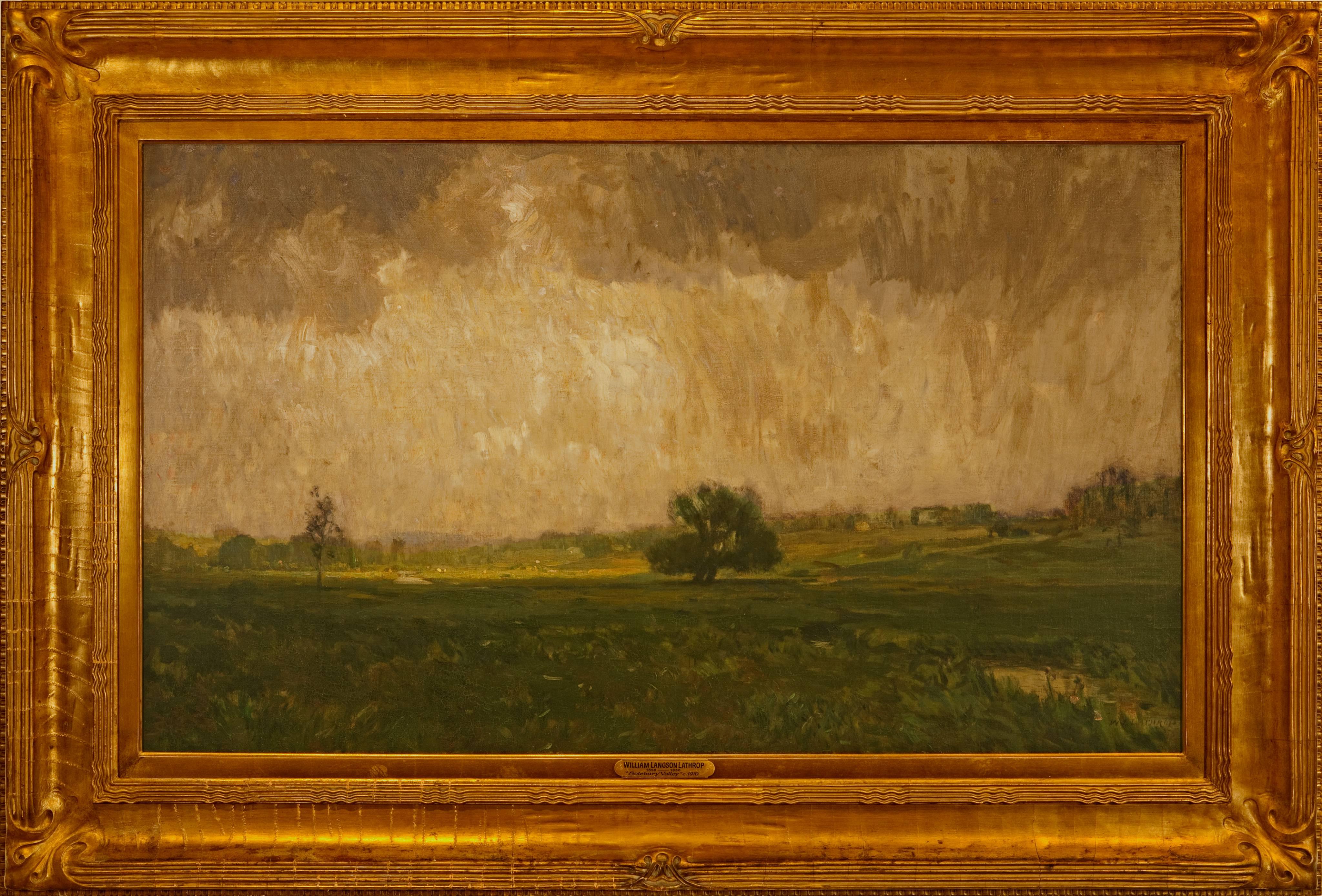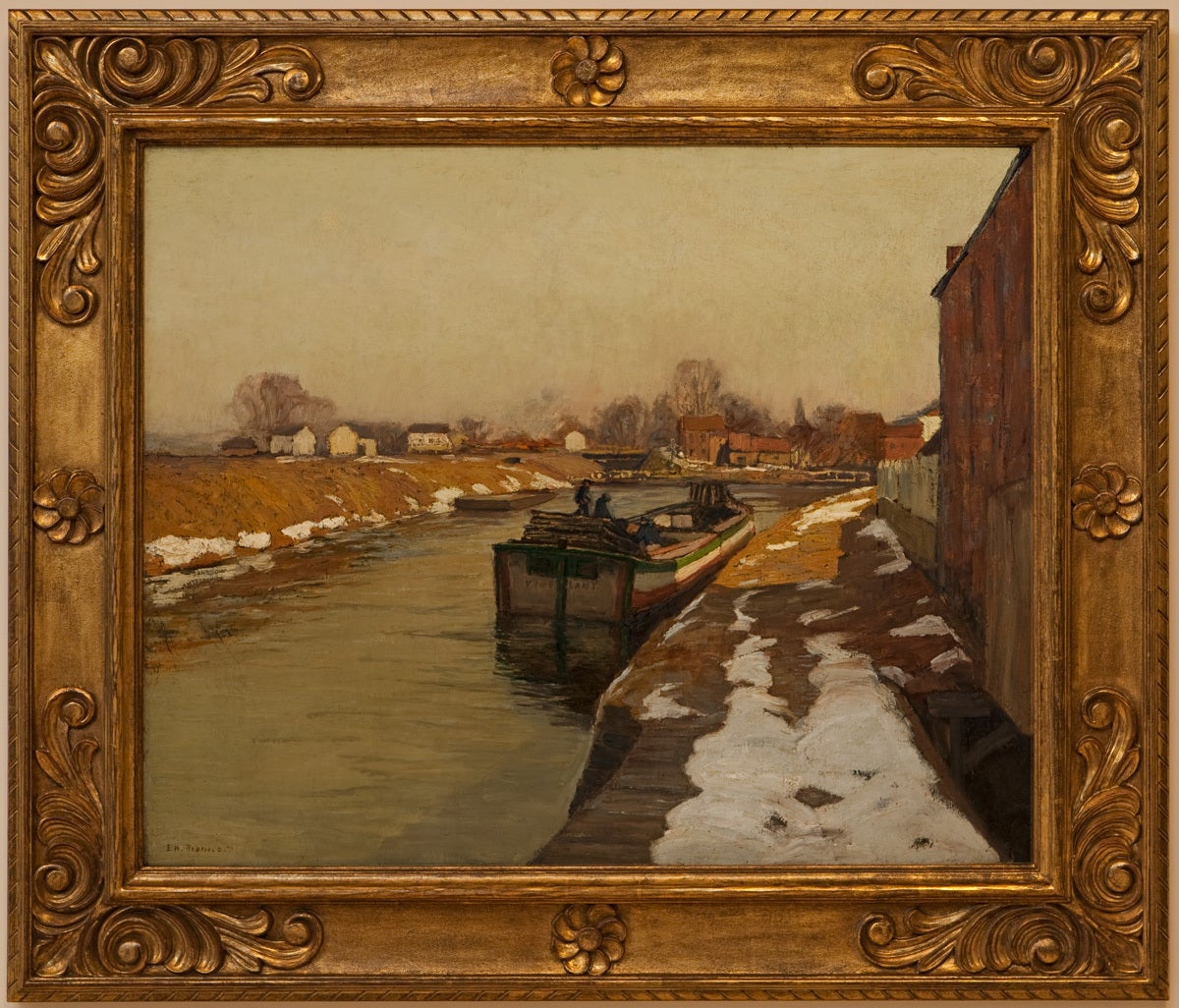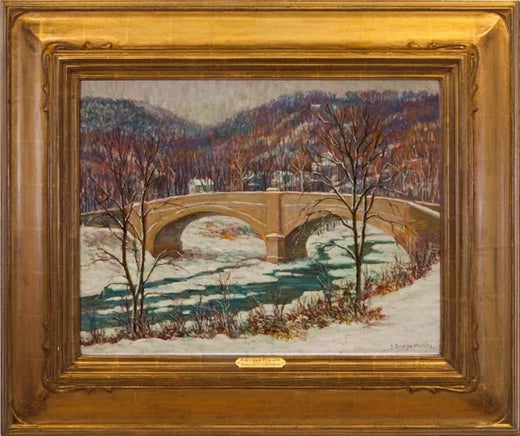Want more images or videos?
Request additional images or videos from the seller
1 of 5
S. George Phillips"Point Pleasant"c. 1920
c. 1920
About the Item
Jim’s of Lambertville is proud to offer this artwork.
Signed lower left.
Complemented by a period frame.
Illustrated in "New Hope for American Art" by Jim Alterman and "The Philadelphia Impressionists" by Thomas C. Folk, pg, 102, plate 45
S. George Phillips (1890 - 1965)
Regarded by some as “a poor man’s Garber” (“poor” needing to be redefined these days), S. George Phillips painted rich and colorful landscapes depicting views of the Delaware River and the environs surrounding New Hope. An extremely competent artist, Samuel George Phillips was born in Pennsylvania in 1890. He studied at the Pennsylvania Academy of the Fine Arts under William Merritt Chase, Cecilia Beaux, Hugh Breckenridge, and Daniel Garber. He then traveled to Europe to continue his studies.
Phillips began his career as an illustrator and commercial artist. His work appeared in The Saturday Evening Post, The Ladies’ Home Journal, McCall’s, and The Liberty Magazine. His best known work as an illustrator was the Santa Claus logo he designed for the Whitman Candy Company.
Around 1915, Phillips established a portrait studio in Philadelphia. Soon he was to become one of Philadelphia’s pre-eminent portraitists, painting many prominent socialites, politicians, and academicians. For fifty years, he commuted from his home in Atlantic City to his Philadelphia studio. Like many artists, painting was Phillips’s livelihood and although landscape painting was his passion, the bills were paid by money earned for commissioned portraits and illustration work. Phillips found portrait painting to be stressful and landscape painting to be relaxing, and as a result, he would frequently spend weekends in Bucks County, taking part-time residence at the Point Pleasant Inn. There, he would drive around the hills of Point Pleasant and the villages of Carversville and Lumberville in search of the perfect composition to paint. Phillips broken brush stroke impressionist style, fresh palette, and keen sense of draftsmanship, strikingly reveals the influence of his former teacher, Daniel Garber. Evidence shows that Phillips on occasion used the name H.C. Lindsay as an alias on his paintings as shown in the work “Near Carversville, Summer” (p. 390). Phillips exhibited his work at the Pennsylvania Academy of the Fine Arts, the National Academy of Design, and the Corcoran Gallery of Art.
Sources
- “New Hope for American Art” by James Alterman
- Bianco Gallery Archives, 1997
- Creator:S. George Phillips (1890-1965, American)
- Creation Year:c. 1920
- Dimensions:Height: 27 in (68.58 cm)Width: 31 in (78.74 cm)Depth: 2 in (5.08 cm)
- More Editions & Sizes:Frame Size 26.5" x 30.0" x 2.5"Price: $74,375
- Medium:
- Movement & Style:
- Period:
- Condition:
- Gallery Location:Lambertville, NJ
- Reference Number:
S. George Phillips
A magazine illustrator early in his career for McCalls and Ladies Home Journal, Samuel George Phillips later devoted himself to portraiture and landscape painting as part of the Pennsylvania Impressionist School, artists who painted in Bucks County after 1915 and were much influenced by Daniel Garber. Of this group, it was written that the earlier Bucks County/New Hope style of Impressionism had been diluted by modernist influences and that "Generally these painters were not as original or creative as the earlier painters, and in fact their work was highly derivative of the art that preceded them in Bucks County." (Folk 31) However, Phillips, a student of Garber's at the Pennsylvania Academy, was described as one of three Garber students whose work "best represent his influence in Bucks County. . . . His work represents some of the finest adaptations of Garber's style." (Folk 102) Other teachers who were influences on Phillips' mostly traditional style were William Merritt Chase, Cecilia Beaux, and Hugh Breckenridge. But judging by his painting, Point Pleasant, Pennsylvania (circa 1920), Phillips did some experimentation with modernism as the work was described as having "an energetic all-over pointalist technique. The entire canvas is composed of tiny brightly colored dots and dashes of pigment." (Folk 102) Samuel George Phillips had studios in New York City, Philadelphia, and also lived in Atlantic City, New Jersey. Memberships included the Philadelphia Art Club. The Pennsylvania Academy was an exhibition venue for the years 1913, 1920-24, 1932 and 1937. He also exhibited work at the Corcoran Gallery and the National Academy of Design.
About the Seller
5.0
Vetted Seller
These experienced sellers undergo a comprehensive evaluation by our team of in-house experts.
Established in 1997
1stDibs seller since 2014
36 sales on 1stDibs
Typical response time: 6 hours
- ShippingRetrieving quote...Ships From: Lambertville, NJ
- Return PolicyThis item cannot be returned.
More From This SellerView All
- "Alley Fiends"By John R. GrabachLocated in Lambertville, NJJim’s of Lambertville is proud to offer this artwork by: John R. Grabach (1886 - 1981) John Grabach was a highly regarded New Jersey artist, teacher, and author of the classic text...Category
1930s American Impressionist Landscape Paintings
MaterialsCanvas, Oil
- "Forest Strongholds"By John F. CarlsonLocated in Lambertville, NJSigned lower right. Complemented by a hand carved and gilt frame. Exhibited at the National Academy of Design, 1928Category
20th Century American Impressionist Landscape Paintings
MaterialsCanvas, Oil
- "Solebury Valley"By William Langson LathropLocated in Lambertville, NJSigned lower right. Complemented by a period frame. William L. Lathrop (1859-1938) Deemed “Father of the New Hope Art Colony”, William Langson Lathrop was born in Warren, Illinois. He was largely self-taught, having only studied briefly with William Merritt Chase in 1887, at the Art Students League. Lathrop first moved east in the early 1880s, and took a job at the Photoengraving Company in New York City. While there, he befriended a fellow employee, Henry B. Snell. The two men became lifelong friends and ultimately, both would be considered central figures among the New Hope Art Colony. Lathrop's early years as an artist were ones of continuing struggle. His efforts to break through in the New York art scene seemed futile, so he scraped enough money together to travel to Europe with Henry Snell in1888. There he met and married an English girl, Annie Burt. Upon returning to New York, he tried his hand at etching, making tools from old saw blades...Category
1910s American Impressionist Landscape Paintings
MaterialsCanvas, Oil
- Winter MoonlightBy George William SotterLocated in Lambertville, NJsigned lower rightCategory
1910s American Impressionist Landscape Paintings
MaterialsCanvas, Oil
- "The Canal"By Edward Willis RedfieldLocated in Lambertville, NJJim’s of Lambertville is proud to offer this artwork. Signed lower left. Complemented by a hand carved and gilt frame. Illustrated in "Edward Redfield: Just Values and Fine Seeing" by Constance Kimmerle and the Pennsylvania Academy of the Fine Arts's Exhibition of Paintings by Edward Redfield (April 17 to May 16, 1909) brochure Edward Willis Redfield (1869 - 1965) Edward W. Redfield was born in Bridgeville, Delaware, moving to Philadelphia as a young child. Determined to be an artist from an early age, he studied at the Spring Garden Institute and the Franklin Institute before entering the Pennsylvania Academy from 1887 to 1889, where he studied under Thomas Anshutz, James Kelly, and Thomas Hovenden. Along with his friend and fellow artist, Robert Henri, he traveled abroad in 1889 and studied at the Academie Julian in Paris under William Bouguereau and Tony Robert-Fleury. While in France, Redfield met Elise Deligant, the daughter of an innkeeper, and married in London in 1893. Upon his return to the United States, Redfield and his wife settled in Glenside, Pennsylvania. He remained there until 1898, at which time he moved his family to Center Bridge, a town several miles north of New Hope along the Delaware River. Redfield painted prolifically in the 1890s but it was not until the beginning of the twentieth century that he would develop the bold impressionist style that defined his career. As Redfield’s international reputation spread, many young artists gravitated to New Hope as he was a great inspiration and an iconic role model. Edward Redfield remained in Center Bridge throughout his long life, fathering his six children there. Around 1905 and 1906, Redfield’s style was coming into its own, employing thick vigorous brush strokes tightly woven and layered with a multitude of colors. These large plein-air canvases define the essence of Pennsylvania Impressionism. By 1907, Redfield had perfected his craft and, from this point forward, was creating some of his finest work. Redfield would once again return to France where he painted a small but important body of work between 1907 and 1908. While there, he received an Honorable Mention from the Paris Salon for one of these canvases. In 1910 he was awarded a Gold Medal at the prestigious Buenos Aires Exposition and at the Panama-Pacific Exposition of 1915 in San Francisco, an entire gallery was dedicated for twenty-one of his paintings. Since Redfield painted for Exhibition with the intent to win medals, his best effort often went into his larger paintings. Although he also painted many fine smaller pictures, virtually all of his works were of major award-winning canvas sizes of 38x50 or 50x56 inches. If one were to assign a period of Redfield’s work that was representative of his “best period”, it would have to be from 1907 to 1925. Although he was capable of creating masterpieces though the late 1940s, his style fully matured by 1907 and most work from then through the early twenties was of consistently high quality. In the later 1920s and through the 1930s and 1940s, he was like most other great artists, creating some paintings that were superb examples and others that were of more ordinary quality. Redfield earned an international reputation at a young age, known for accurately recording nature with his canvases and painting virtually all of his work outdoors; Redfield was one of a rare breed. He was regarded as the pioneer of impressionist winter landscape painting in America, having few if any equals. Redfield spent summers in Maine, first at Boothbay Harbor and beginning in the 1920s, on Monhegan Island. There he painted colorful marine and coastal scenes as well as the island’s landscape and fishing shacks. He remained active painting and making Windsor style furniture...Category
Early 1900s American Impressionist Landscape Paintings
MaterialsCanvas, Oil
- "In Port"By Edward Willis RedfieldLocated in Lambertville, NJJim’s of Lambertville is proud to offer this artwork by: Edward Willis Redfield (1869 - 1965) Edward W. Redfield was born in Bridgeville, Delaware, moving to Philadelphia as a young child. Determined to be an artist from an early age, he studied at the Spring Garden Institute and the Franklin Institute before entering the Pennsylvania Academy from 1887 to 1889, where he studied under Thomas Anshutz, James Kelly, and Thomas Hovenden. Along with his friend and fellow artist, Robert Henri, he traveled abroad in 1889 and studied at the Academie Julian in Paris under William Bouguereau and Tony Robert-Fleury. While in France, Redfield met Elise Deligant, the daughter of an innkeeper, and married in London in 1893. Upon his return to the United States, Redfield and his wife settled in Glenside, Pennsylvania. He remained there until 1898, at which time he moved his family to Center Bridge, a town several miles north of New Hope along the Delaware River. Redfield painted prolifically in the 1890s but it was not until the beginning of the twentieth century that he would develop the bold impressionist style that defined his career. As Redfield’s international reputation spread, many young artists gravitated to New Hope as he was a great inspiration and an iconic role model. Edward Redfield remained in Center Bridge throughout his long life, fathering his six children there. Around 1905 and 1906, Redfield’s style was coming into its own, employing thick vigorous brush strokes tightly woven and layered with a multitude of colors. These large plein-air canvases define the essence of Pennsylvania Impressionism. By 1907, Redfield had perfected his craft and, from this point forward, was creating some of his finest work. Redfield would once again return to France where he painted a small but important body of work between 1907 and 1908. While there, he received an Honorable Mention from the Paris Salon for one of these canvases. In 1910 he was awarded a Gold Medal at the prestigious Buenos Aires Exposition and at the Panama-Pacific Exposition of 1915 in San Francisco, an entire gallery was dedicated for twenty-one of his paintings. Since Redfield painted for Exhibition with the intent to win medals, his best effort often went into his larger paintings. Although he also painted many fine smaller pictures, virtually all of his works were of major award-winning canvas sizes of 38x50 or 50x56 inches. If one were to assign a period of Redfield’s work that was representative of his “best period”, it would have to be from 1907 to 1925. Although he was capable of creating masterpieces though the late 1940s, his style fully matured by 1907 and most work from then through the early twenties was of consistently high quality. In the later 1920s and through the 1930s and 1940s, he was like most other great artists, creating some paintings that were superb examples and others that were of more ordinary quality. Redfield earned an international reputation at a young age, known for accurately recording nature with his canvases and painting virtually all of his work outdoors; Redfield was one of a rare breed. He was regarded as the pioneer of impressionist winter landscape painting in America, having few if any equals. Redfield spent summers in Maine, first at Boothbay Harbor and beginning in the 1920s, on Monhegan Island. There he painted colorful marine and coastal scenes as well as the island’s landscape and fishing shacks. He remained active painting and making Windsor style furniture...Category
Early 1900s American Impressionist Landscape Paintings
MaterialsCanvas, Oil
You May Also Like
- At the ClotheslineBy Irving Ramsey WilesLocated in New York, NYSigned lower right: Irving R. WilesCategory
Late 19th Century American Impressionist Landscape Paintings
MaterialsCanvas, Oil
- California LandscapeBy William WendtLocated in Palm Desert, CA"California Landscape" is a painting by California Impressionist William Wendt. The painting is signed lower left, "William Wendt 1917". The frame...Category
1910s American Impressionist Landscape Paintings
MaterialsOil, Canvas
- Laguna HillsBy William WendtLocated in Palm Desert, CAA painting by William Wendt. "Laguna Hills" is an impressionist landscape, oil on canvas in an earth-tone palette by American artist William Wendt. The artwork is signed in the lower...Category
Early 20th Century American Impressionist Landscape Paintings
MaterialsOil, Canvas
- Peasant woman at work in the fields of CapriBy Charles Caryl ColemanLocated in Roma, RMCharles Caryl Coleman (Buffalo 1840 – Capri 1928), Peasant woman at work in the fields of Capri (1901) Oil painting on canvas 35 x 49 cm, signed, located and dated Capri 1901 lower ...Category
Early 1900s American Impressionist Landscape Paintings
MaterialsCanvas, Oil
- The Island, DANIEL RIDGWAY KNIGHT - American Impressionist, Realism, Landscape,By Daniel Ridgway KnightLocated in London, GBOil on canvas 46 x 55 cm (18 ⅛ x 21 ⅝ inches) Signed lower left, Ridgway Knight Artist biography American artist Daniel Ridgway Knight was born in Pennsylvania and studied at the École des Beaux-Arts in Paris. From 1872 he lived and worked at Poissy on the River Seine, just to the west of Paris. Best known for his landscapes and depictions of peasant women in the fields, Knight earned distinction at the Paris Salon of 1882. He went to be was awarded the Silver Medal and Cross of the Legion d’Honneur at the Exposition Universelle in 1889, the Gold Medal of Honour from the Pennsylvania Academy of Fine Arts in 1893 and in that same year was created a Knight of the Royal Order...Category
Late 19th Century American Impressionist Landscape Paintings
MaterialsOil, Canvas
- Grey Day on the BayBy Lu HaskewLocated in Loveland, CO"Grey Day on the Bay" by Lu Haskew Oil 24x28" framed, 16x20" image size Signed lower left When Lu visited her sister in Oregon she always made a point of visiting the ships at dock ...Category
Early 2000s American Impressionist Paintings
MaterialsCanvas, Oil






